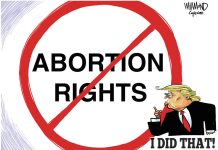It’s no secret that fewer Hoosiers are going to college, but with the rate falling to near half of graduating seniors, the trend has grown troubling enough that it cannot be ignored. When the percentage of Hoosier students who go to college falls from 65% in 2015 to just 53% in 2020, something is not adding up.
At a recent panel discussion at at the Columbus Learning Center hosted by IUPUC and covered by The Republic’s Jana Wiersema, Sean Tierney and Jose Medina from the Indiana Commission for Higher Education gave context to these numbers and discussed what can be done to increase educational attainment rates.
There are plenty of wherefores and whys behind the decline in Hoosiers going to college. An economy offering young people never-before-seen entry-level wages may be luring greater numbers into the workforce and away from post-secondary education. And many young people have legitimate trepidation regarding the cost, and perhaps the value proposition, of a college education. The reasons a student chooses to go to college — or not — are as varied as the students’ individual circumstances.
As Wiersema reported, Tierney and Medina “emphasized the need for better communication when it comes to informing students about the different post-secondary opportunities available to them and convincing them of the value of pursuing further education.”
” … (W)e’ve really struggled, both as a state and as institutions, to really find successful ways to push back on that narrative, whether right or wrong, that college is not worth it. And we’re starting to see the results of that loss in the messaging battle,” Tierney said.
Young people should have all the information about their education funding options, yet they may not. Here are a few things they should know:
- Indiana’s 21st Century Scholars Program provides up to 100% of tuition at public colleges in-state and partial tuition at private colleges for students whose families are income-eligible in grades 7 and 8. Medina and Tierney would like enrollment in this program to be automatic for eligible students. We agree. Meantime, eligible students should enroll, because the program simply makes available potential college funding while fostering academic achievement.
- Indiana’s need-based Frank O’Bannon Grants help about 40,000 Hoosiers afford college each year, and the state has just bulked up these grants by 35% starting next school year to compensate for rising college costs. That means these grants will provide up to $6,200 in annual aid for public schools or $12,400 for private institutions.
- The Free Application for Federal Student Aid (FAFSA) opens doors to a wide range of options for funding post-secondary education. A student who doesn’t file might never know what they may be missing. There is nothing to lose by filing, and there could be much to gain.
- Speaking of funding, there is also this: $15,000. That’s the average amount more that a Hoosier with a bachelor’s degree earns annually compared with someone with only a high school diploma, according to the Indiana Business Research Center at the Indiana University Kelley School of Business.
We can’t fail our students when it comes to helping them realize their options and opportunities so they can plan wisely for their future.




